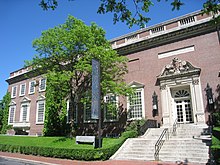Edward W. Forbes
Edward W. Forbes | |
|---|---|
| Born | Edward Waldo Forbes July 16, 1873 |
| Died | March 11, 1969 (aged 95) |
| Education | Milton Academy |
| Alma mater | Harvard University |
| Spouse | Margaret Laighton |
| Children | 5 |
| Parent(s) | William Hathaway Forbes Edith Emerson Forbes |
| Relatives | John Murray Forbes (paternal grandfather) Robert Bennet Forbes (paternal great-uncle) William Emerson (maternal great-grandfather) Ralph Waldo Emerson (maternal grandfather) William Cameron Forbes (brother) |
Edward Waldo Forbes (1873-1969) was an American art historian. He was the Director of the
Early life
Edward Waldo Forbes, of the
Forbes was educated at the Milton Academy, a boarding school in Milton, Massachusetts.[1][3] He graduated from Harvard University in 1895.[1][3] While he was at Harvard, he attended art history lectures by Charles Eliot Norton.[1] Forbes traveled to Europe in 1908, where he studied Italian paintings.[2] He attended the University of Oxford, studying English Literature from 1900 to 1902.[2]
Career
Forbes co-founded the Harvard River Associates in 1902 with Robert Bacon, James Abercrombie Burden, Jr., Augustus Hemenway and Thomas Nelson Perkins.[2][5] The real estate venture consisted in acquiring land between the Harvard Yard and the Charles River for US$400,000 to preserve the beauty of the area near the Harvard campus remained "collegiate".[5] Subsequently, the land became part of the campus in its expansion.[2]

Forbes taught at his alma mater, Middlesex School, from 1904 to 1905.[2] By 1907, he conducted a course on Florentine painting at his other alma mater, Harvard University. He became a lecturer in Fine Arts at Harvard in 1909.[2] By 1935, he was promoted as the Martin A. Ryerson Professor in the Fine Arts at Harvard University.[1] He retired in 1944.[1][3]
Forbes served as the Director of the
Forbes served as the President of the American Research Center in Egypt from 1948 to 1962.[1]
The first Honorary Fellowship of the International Institute for Conservation of Historic and Artistic Works (IIC) was awarded to Edward Forbes in 1958.[8]
As a permanent tribute, the plaza outside and the arcade inside Harvard's
Forbes Prize Lecture
In 1958 a Forbes Prize Fund had been set up at the Fogg Art Museum (now part of
Forbes Pigment Collection
The Forbes’ Pigment Collection contains over 3000 colorants assembled by Edward Waldo Forbes. Currently, the core collection of pigments is housed in the Straus Center for Conservation and Technical Studies, Harvard Art Museums, while Forbes’ private collection of pigments resides at the New York University Institute of Fine Arts Conservation Center.
Philanthropy
Forbes served in the American Red Cross during World War I.[1]
Forbes served on the board of trustees of the
Forbes was a recipient of an honorary A.M. from Harvard in 1921, an honorary LL.D. from the
Personal life
Forbes married Margaret Laighton in 1907.[1][10] They had five children,[2] including John Murray Forbes, Mary Emerson Forbes, Elliott Forbes, Anne Forbes,[11] and Rosamond (Mrs. Carl Pickhardt).[10] They resided at Gerry's Landing in Cambridge, Massachusetts.[2] His wife predeceased him in 1966.[10]
Forbes was an avid amateur painter and sailor.[2]
Death
Forbes died on March 11, 1969, at the McLean Hospital in Belmont, a suburb of Boston in Massachusetts.[1][10][12] He was ninety-five years old.
Further reading
- Agnes Mongan, John Coolidge, José Luis Sert, George Leslie Stout, Elizabeth H. Jones. Edward Waldo Forbes: Yankee Visionary. (Cambridge, Mass.: Fogg Art Museum, Harvard University, 1971).
References
- ^ a b c d e f g h i j k l m n o p q r s t u v "Forbes, Edward Waldo". Dictionary of Art Historians. Archived from the original on June 13, 2012. Retrieved October 12, 2012.
- ^ a b c d e f g h i j k l "Forbes, Edward Waldo, 1873-1969. Papers, 1867-2005: A Guide". Harvard University Library. Harvard University. Archived from the original on April 3, 2015. Retrieved October 12, 2012.
- ^ a b c d e f g h "Edward W. Forbes (1873–1969)". Dumbarton Oaks. Retrieved October 12, 2012.
- ^
- ^
- ^ a b Kino, Carol (March 19, 2014). "Monuments Man in War, Conservator in Peace". The New York Times. Retrieved October 12, 2015.
- ^ https://myiicaccount.iiconservation.org/honorary-fellows
- ^ Edward Waldo Forbes: Yankee Visionary, Fogg Art Museum, Harvard University, 1971
- ^
- ^ [1] Anne Forbes' Smithsonian Collection on American Indian Art
- ^ "Edward Forbes of Fogg Museum: First Curator Dies at 95—Noted Harvard Teacher" (PDF), The New York Times, New York City, June 5, 2011, retrieved October 12, 2015
